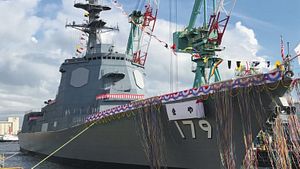The Japan Maritime Self Defense Force (JMSDF) Atago-class (aka 27DD- or 27DDG-class) guided missile destroyer, the future Maya (PN 179), completed its second round of sea trials late last month, according to local media reports.
The improved Atago-class is based on the JMSDFs older Kongō-class, which in turn is based on the U.S. Navy’s Arleigh Burke-class of guided missile destroyers, although the Atago-class displacing around 1,000 tons more than the latest Arleigh Burke-class variant. The improved Atago-class is also around five meters longer than the original Atago-class destroyers. The JMSDF plans to deploy two upgraded warships of the class by the spring of 2021.
The improved 8,200-ton Atago-class destroyer is on track to be commissioned in March 2020. The future JS Maya is named after Mount Maya in the Rokko mountain range in Kobe, Hyogo Prefecture on Honshu island. Japan Marine United (JMU) Corporation launched the Maya at its facility in Yokohama on July 30. Construction costs of the surface combatant are estimated at around $1.5 billion.
The Maya is the seventh JMSDF surface combatant to be equipped with the Aegis combat system. Specifically, it will be equipped with the Aegis Baseline J7, the Japanese equivalent to the U.S. Navy’s Baseline 9/BMD 5.1 standard Aegis combat system, which has been designed for ballistic missile defense. Aegis Baseline J7, supported by the Lockheed Martin AN/SPY-1D-series radar, can also engage in simultaneous air and ballistic missile defense.
Development of the Aegis Baseline 9/BMD 5.1 has been jointly funded by the U.S. and Japanese governments. The U.S. Naval Sea Systems Command awarded Lockheed Martin a $135.8 million contract for work on the development and integration of the Aegis Baseline 9 systems for the improved Atago-class of guided missile destroyers in December 2017.
The improved Atago-class will also receive the Northrop Grumman AN/SPQ-9B radar system reportedly capable of detecting and tracking low-flying, supersonic, low observable anti-ship missiles.
The new improved Atago-class will be armed with the SM-3 Block IIA, which has been under joint development by U.S. defense contractor Raytheon and Japan’s Mitsubishi Heavy Industries since 2006. The SM-3 Block IIA can destroy incoming ballistic missile targets in midcourse. The SM-3 interceptor is specifically designed to destroy short- to intermediate-range ballistic missiles.
Notably, despite earlier reports to the contrary, the improved Atago-class will also receive Standard Missile-6 (SM-6) interceptors.
Additional armaments will include RIM-66 Standard Missile-2(SM-2) surface-to-air missiles and the RIM-162 Evolved Sea Sparrow Missile (ESSM), all of which launched from the Maya’s 96 Mk 41 vertical launch system cells.
To facilitate data-sharing with US warships and enhance the interoperability between the JMSDF and the U.S. Navy, the improved Atago-class will also be fitted with a cooperative engagement capability (CEC), “a new wide-area integrated air defense system, which permits the real-time sharing of sensor data on air targets, including incoming enemy aircraft and cruise missiles, among CEC-equipped ships,” as I explained elsewhere.































